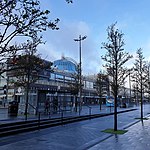The James Young High School
The James Young High School is a secondary school in Dedridge, Livingston, West Lothian, Scotland. The school opened in 1982 and was named after James Young, who patented the process of extracting oil from coal and shale. James Young High is a coeducational state school which has over 1100 pupils. The headteacher was Christopher Horne until the 2012–2013 school year when he retired and was replaced by Catrina Hatch. In 2018 she was then replaced by the previous Depute Head teacher P Gallacher. She is assisted by her Depute Headteachers G Hope, C McTiernan and A McKeown. There are also 7 PTCs for Curriculum and 4 PTCs for Pupil Support. The school uniform consists of a white shirt with purple tie and optional jumper.
Excerpt from the Wikipedia article The James Young High School (License: CC BY-SA 3.0, Authors).The James Young High School
Almondvale Road,
Geographical coordinates (GPS) Address Phone number External links Nearby Places Show on map
Geographical coordinates (GPS)
| Latitude | Longitude |
|---|---|
| N 55.8802 ° | E -3.51537 ° |
Address
The James Young High School
Almondvale Road
EH54 6NE , Dedridge
Scotland, United Kingdom
Open on Google Maps





